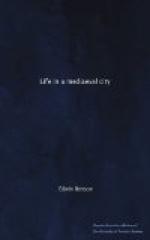Such was the general state of affairs. Nevertheless the forms and practices of the Church continued. The granting of indulgences and pardons, the inexhaustible demand for Peter’s pence, went on vigorously. A recognised means of publicly raising funds was employed in February 1455-6, when the Archbishop proclaimed an indulgence of forty days to those who would help the Friars Preachers, whose cloister and buildings including 34 cells together with their books, vestments, jewels, and sacred vessels, had been destroyed by fire.
The faith of the ordinary citizen was, however, intact. The Church came into the people’s life daily. The citizen could not walk away from his home without seeing a church, and meeting a priest or a friar. He attended the Church services and fulfilled his religious duties. Baptism, marriage, death, illness, public rejoicing, soldiering, dramatic entertainments, the language of daily life—all these bore the stamp of the Church. The very days of relief from work were holy-days, feast days in the Church’s calendar. Taking part in the public processions on Corpus Christi Day, a great annual holiday, was a religious exercise; at the same time this day was devoted especially to entertainment. Wills of the century show that the citizens lived as religiously as formerly. This spirit is seen perhaps most characteristically in the numbers of candles that wealthy citizens bequeathed for use in church, and in the sums of money they left to specified clergy and other “religious” for the provision of masses for the souls of themselves, their wives and families, and for those for whom they ought to pray. Masses were thus provided for by hundreds, and in some cases by thousands. The following extracts from the will[5] of a rich citizen and merchant of York, who had been sheriff and mayor of the city, show admirably the spirit of a member of the middle class in the fifteenth century:—
“In the name of God Amen. The 4th day of September in the year of our Lord 1436, I Thomas Bracebrig, Citizen and merchant, York, sound of mind and having health of body, establish and dispose my Will in this manner. First, I command and bequeath my soul to God Almighty, to the blessed Mary, Mother of God and ever Virgin, and to All Saints, and my body to be buried in the parish church of St. Saviour in York, before the image of the Crucifix of our Lord Jesus




